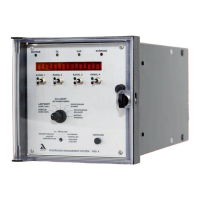7
4 System Operation
4.1.2 O
2
Trim Modes
ES indicates that although the mode selector switch is on SETTING.
It's control function is working according to a calculated curve in the
RAM. The curve is calculated from a partial curve, which is already
entered. This mode is reached if the burner is switched off and is
restarted during a programming sequence. The programming can be
continued by operating a switch (change to ’EI’ mode). Flame signal and
control release are present.
ST indicates that the FMS is set to FAULT. The fault code can be called up in
switch position STATUS. In the switch position FIRING RATE the firing-
rate at the time when the fault occurs, is displayed.
VO
EV
indicates that FMS is in PRE-PURGE mode. PRE-PURGE is
active.Switching to SETTING only changes the indication of the mode in
EV. Programming is not possible in this mode.
HAND
or
HA
indicates that the FMS has been switched to manual mode whilst the
burner is running. In the selector switch position FIRING RATE the
firing-rate can be adjusted by actuating the channel 1 switch. To quit
manual mode, actuate any switch but the channel 1 switch.
ext.Hand indicates that the FMS was switched to manual operation, but the firing-
rate was specified externally and not via the channel 1 key (that is, e.g.
via remote software or bus).
LE indicates that the output controller of the FMS is deactivated and the fir-
ing rate is controlled by an external signal
op O
2
trim in standby (during burner start-up), or O
2
trim temporarily switched off as a
function firing rate via parameters 914 and 915.
or O
2
- trim active.
ot O
2
trim temporarily deactivated (air deficiency, probe dynamics etc).
od O
2
trim deactivated (fault), e.g. test routine failed during burner start-up, dynamic test
negative, O
2
trim temporarily deactivated for over 1 hour etc.
C Optimisation at increasing firing rate
c Optimisation at decreasing firing rate

